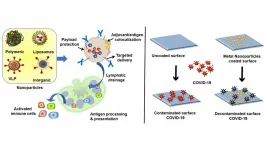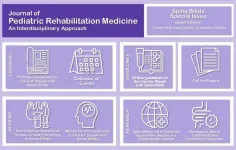Biomaterials could mean better vaccines, virus-fighting surfaces
Scientists are working toward advances that, using nanotechnology, could lead to a hospital bed or doorknob that naturally destroys viruses.
2021-02-09
(Press-News.org) WASHINGTON, February 9, 2021 -- Advances in the fields of biomaterials and nanotechnology could lead to big breakthroughs in the fight against dangerous viruses like the novel coronavirus that causes COVID-19.
In APL Bioengineering, by AIP Publishing, researchers from the Indian Institute of Science describe two possibilities being explored by scientists in the field to make vaccines more effective and build surfaces that could fight and kill viruses on their own.
"It is important not just in terms of COVID," said author Kaushik Chatterjee. "We've seen SARS, and MERS, and Ebola, and a lot of other viral infections that have come and gone. COVID has, of course, taken a different turn altogether. Here, we wanted to see how biomaterials could be useful."
Biomaterials are materials engineered to interact with other biological systems in some way. Examples include joint replacements, dental implants, surgical mesh, and drug delivery systems.
Nanotechnology, meanwhile, focuses on building tiny structures and devices at the microscopic level. It has been used in the medical field to target specific cells or tissues.
It is the combination of the two that could lead to more effective vaccines against viruses. While some current vaccines are already effective, the authors said biomaterials-based nanoparticles could one day be used to make them even stronger.
"It is a means of stimulating the immune cells which produce antibodies during the vaccination," said author Sushma Kumari. "It is like a helper, like priming the cells. Now, the moment they see the protein, the cells are more responsive to it and would be secreting more antibodies."
At the same time, researchers are studying ways the technology could be used to curb the spread of viruses in the world around us. Currently, the techniques used to disinfect surfaces in public places, from conventional cleaning to aerosols to ultraviolet light, can require lots of time and effort.
Emerging bioengineering technologies would create antiviral surfaces that could disinfect themselves.
"As viruses end up as droplets on various surfaces, the next person touching that could be picking up the disease," Chatterjee said.
By putting a natural charge on the surface or designing it at the nano-level in an unfriendly pattern for the virus, masks, PPE suits, hospital beds, doorknobs, and other items could be created that automatically damage or destroy a virus.
The authors note this research is in its infancy. Much work remains to be done to learn which of many biomaterials may be most effective at fighting viruses, and an answer for one disease likely will not be the same for others.
"Hopefully, this review and this kind of discussion will get researchers to think about how to use the knowledge that's out there," said Chatterjee.
INFORMATION:
The article "Biomaterials-based formulations and surfaces to combat viral infectious diseases" is authored by Kaushik Chatterjee and Sushma Kumari. The article will appear in APL Bioengineering on Feb. 9, 2021 (DOI: 10.1063/5.0029486). After that date, it can be accessed at https://aip.scitation.org/doi/10.1063/5.0029486.
ABOUT THE JOURNAL
APL Bioengineering is an open access journal publishing significant discoveries specific to the understanding and advancement of physics and engineering of biological systems. See http://aip.scitation.org/journal/apb.
[Attachments] See images for this press release:

ELSE PRESS RELEASES FROM THIS DATE:
2021-02-09
FOLSOM, Calif., February 9, 2021 - A new animal study, published in the Journal of Clinical Biochemistry and Nutrition, suggests regular walnut consumption may be a promising intervention for reducing negative outcomes associated with Helicobacter pylori (H. pylori) infection, a widespread bacterial infection that affects more than half of the world's population.
Using mice models, researchers from the CHA Cancer Prevention Research Center in Korea found preliminary evidence that eating a diet rich in walnuts may help protect against negative outcomes associated with H. pylori infection. Specifically, the research found that walnut extracts, formed from ...
2021-02-09
Within the constellation Cygnus, an elderly star and its massive companion are having one last hurrah, flinging off mass at an incredible rate before they explode as supernovae and collapse into a black hole.
Now, researchers including recent Embry-Riddle Aeronautical University graduate Laura M. Lee have mapped the elderly star's orbit around its oversized and equally ancient partner. In a scientific first, they have also determined the dynamical mass of both stars that make up a binary system called Wolf-Rayet 133.
The team's findings, published Feb. 9, 2021 by Astrophysical Journal ...
2021-02-09
While the World Health Organization (WHO) continues its mission to Wuhan investigating the origin and early transmission of SARS-CoV-2, a new study led by scientists from Duke-NUS Medical School, Singapore, and Chulalongkorn University, Thailand, shows that SARS-CoV-2-related coronaviruses (SC2r-CoVs) are circulating in animals as far away as Thailand. The study, published in Nature Communications today, reported that high levels of neutralising antibodies against the virus were present in both bats and pangolins found in the Southeast Asian country. The study further indicates that more SC2r-CoVs are likely to be discovered ...
2021-02-09
Amsterdam, NL, February 9, 2021 - Globally, nearly 300,000 babies are born with neural tube defects including spina bifida (SB) each year. This openly available special issue of the Journal of Pediatric Rehabilitation Medicine (JPRM) provides 20 important evidence- and consensus-based updates to key sections of the 2018 "Guidelines for the Care of People with Spina Bifida" issued by the Spina Bifida Association (SBA). These reflect current recommendations for the care of patients with SB across the entire lifespan, from prenatal counseling to adult care.
As a result of research advancements and improved team-based patient care, approximately 80%-90% of children with SB now live to adulthood in the United ...
2021-02-09
A study of women who were new mothers in the late 1970s found that those who were given longer, paid maternity leave lived healthier lives as they entered middle age.
While universal paid maternity leave is now available in many Western European nations, this has not always been the case. A new study by University of Georgia economist Meghan Skira looked at the health of Norwegian mothers before and after paid maternity leave became law in 1977. She found that the health benefits of leave continued for years after their children were born.
Skira, an associate professor in the Terry College of Business, worked with economist Aline Bütikofer of the Norwegian School of Economics and Julie Riise of the University of Bergen on the study. Their paper, "The Impact of Paid ...
2021-02-09
A study led by researchers at the University of Minnesota Medical School found a way to detect the presence of ovarian cancer in patients using Pap test samples, normally used to detect cervical cancer. Currently, no early warning system exists for ovarian cancer, which in 2021, is estimated to kill more than 13,700 women, according to the American Cancer Society.
"It is known as a 'silent killer' since women with early stages of ovarian cancer have symptoms that can often be confused with other ailments. Women are typically diagnosed when the cancer has progressed so far that other organs are involved, requiring major surgery and chemotherapy," ...
2021-02-09
Russian researchers from HSE University have studied a hypothesis regarding the capability of the visual system to automatically categorize objects (i.e., without requiring attention span). The results of a simple and beautiful experiment confirmed this assumption. The paper was published in the journal Scientific Reports. The study was supported by a Russian Science Foundation grant.
Humans receive a lot of information from the environment through their vision. Every day, we face a flow of varied visual stimuli. At the same time, information processing requires cognitive resources. Like a computer processor, the human brain has limited capacity in terms of the data it is able to process and save ...
2021-02-09
Anaphylaxis is a systemic allergic reaction that can affect the skin, the gastrointestinal tract, the respiratory system and the cardiovascular system. The most severe form of anaphylaxis is anaphylactic shock, which features hypotension and can cause death. This reaction can have several causes, such as allergic reactions to food, medicines or insect venom.
The molecular mechanisms that cause the severity of these kinds of reactions is still unknown. In a study led by researchers of the University of Barcelona and IDIBAPS, researchers analyzed the mutation of a gen detected in a patient who suffered from recurrent anaphylactic shocks caused ...
2021-02-09
Growing the right crop in the right place within an impaired watershed can achieve significant water quality improvements, according to Penn State researchers, who conducted a novel study in the drainage of a Susquehanna River tributary in an agricultural area in southeastern Pennsylvania.
The research may reveal a potential path for restoring the troubled Chesapeake Bay, said Patrick Drohan, associate professor of pedology in the College of Agricultural Sciences and one of the study's authors. The bay -- which long has been impaired in large part by nutrients and sediment washing off crop fields and getting into surface waters that feed it -- needs bold solutions, such as changing cropping systems, he suggested.
"Other than when wastewater treatment plants came into compliance ...
2021-02-09
BROOKLYN, New York, Monday, February 8, 2021 -- A holy grail for orthopedic research is a method for not only creating artificial bone tissue that precisely matches the real thing, but does so in such microscopic detail that it includes tiny structures potentially important for stem cell differentiation, which is key to bone regeneration.
Researchers at the NYU Tandon School of Engineering and New York Stem Cell Foundation Research Institute (NYSF) have taken a major step by creating the exact replica of a bone using a system that pairs biothermal imaging with a heated "nano-chisel." In a study, "Cost and Time Effective Lithography of Reusable Millimeter Size Bone Tissue Replicas with Sub-15 nm Feature Size on a Biocompatible ...
LAST 30 PRESS RELEASES:
[Press-News.org] Biomaterials could mean better vaccines, virus-fighting surfaces
Scientists are working toward advances that, using nanotechnology, could lead to a hospital bed or doorknob that naturally destroys viruses.





